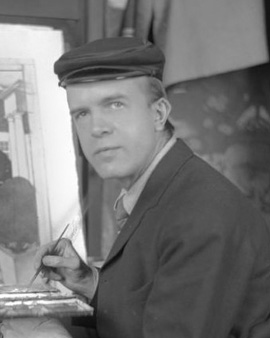The last years of the 19th century can undoubtedly be called the height of illustration art. At that time, posters and billboards, magazines and book titles were designed almost exclusively by illustrators, whose art was thus the focus of public attention. One of those who had a decisive influence on this period was Edward Penfield, who was born in Brooklyn and is often regarded today as the "father of the American poster". Penfield had enjoyed formal artistic training at the New York Art Student`s League and then moved on to the famous Harper`s Magazine, whose artistic director he later became. In this role, Penfield was responsible for the design of the magazine's cover pages.
It is thanks to Penfield's individual style that these covers have become contemporary works of art, making illustration an even more widely recognized art form. To this day, these works with their expressive elegance are symbolic of the time around the turn of the century. Penfield achieved this recognition through the use of new available techniques, especially in the field of color printing. In the figures he drew, he dispensed with too many details and used strong lines for contouring. Inspired by Japanese artists and poster art, which was growing in Europe at about the same time, Penfield established illustration as a separate art form and prepared the ground for the subsequently developing discipline of graphic design.
×





.jpg)
.jpg)
.jpg)
.jpg)
.jpg)
.jpg)
_-_(MeisterDrucke-383709).jpg)
_-_(MeisterDrucke-383709).jpg)
.jpg)
.jpg)
.jpg)
.jpg)
.jpg)
.jpg)
.jpg)
.jpg)
.jpg)
.jpg)
.jpg)
.jpg)
.jpg)
.jpg)
.jpg)
.jpg)
.jpg)
.jpg)
.jpg)
.jpg)
.jpg)
.jpg)
.jpg)
.jpg)
.jpg)
.jpg)
.jpg)
.jpg)
.jpg)
.jpg)
.jpg)
.jpg)
.jpg)
.jpg)
.jpg)
.jpg)
_French_military_commander_Edward_Penfield_(1866-1925)_-_(MeisterDrucke-980545).jpg)
_French_military_commander_Edward_Penfield_(1866-1925)_-_(MeisterDrucke-980545).jpg)
.jpg)
.jpg)
.jpg)
.jpg)
.jpg)
.jpg)
.jpg)
.jpg)
.jpg)
.jpg)
.jpg)
.jpg)
.jpg)
.jpg)
.jpg)
.jpg)
.jpg)
.jpg)
.jpg)
.jpg)
.jpg)
.jpg)
.jpg)
.jpg)
_-_(MeisterDrucke-602511).jpg)
_-_(MeisterDrucke-602511).jpg)
.jpg)
.jpg)
.jpg)
.jpg)
_-_(MeisterDrucke-602512).jpg)
_-_(MeisterDrucke-602512).jpg)
.jpg)
.jpg)
.jpg)
.jpg)
.jpg)
.jpg)
.jpg)
.jpg)
.jpg)
.jpg)
_-_1899_-_Colour_l_-_(MeisterDrucke-1317845).jpg)
_-_1899_-_Colour_l_-_(MeisterDrucke-1317845).jpg)
.jpg)
.jpg)
_-_(MeisterDrucke-1020568).jpg)
_-_(MeisterDrucke-1020568).jpg)
.jpg)
.jpg)
.jpg)
.jpg)
.jpg)
.jpg)
.jpg)
.jpg)
.jpg)
.jpg)
_colour_By_Edward_Pen_-_(MeisterDrucke-980546).jpg)
_colour_By_Edward_Pen_-_(MeisterDrucke-980546).jpg)
.jpg)
.jpg)
.jpg)
.jpg)
.jpg)
.jpg)
_by_Edward_Penfield_1866-19_-_(MeisterDrucke-935254).jpg)
_by_Edward_Penfield_1866-19_-_(MeisterDrucke-935254).jpg)
.jpg)
.jpg)
.jpg)
.jpg)
.jpg)
.jpg)
.jpg)
.jpg)
.jpg)
.jpg)
_-_(MeisterDrucke-394382).jpg)
_-_(MeisterDrucke-394382).jpg)
.jpg)
.jpg)
.jpg)
.jpg)
_-_(MeisterDrucke-383715).jpg)
_-_(MeisterDrucke-383715).jpg)
_-_(MeisterDrucke-1014455).jpg)
_-_(MeisterDrucke-1014455).jpg)
_-_(MeisterDrucke-1456100).jpg)
_-_(MeisterDrucke-1456100).jpg)
.jpg)
.jpg)
.jpg)
.jpg)
.jpg)
.jpg)
.jpg)
.jpg)
.jpg)
.jpg)
_-_(MeisterDrucke-1008060).jpg)
_-_(MeisterDrucke-1008060).jpg)
.jpg)
.jpg)
.jpg)
.jpg)
.jpg)
.jpg)
.jpg)
.jpg)
_-_(MeisterDrucke-602513).jpg)
_-_(MeisterDrucke-602513).jpg)
_-_(MeisterDrucke-1585227).jpg)
_-_(MeisterDrucke-1585227).jpg)
.jpg)
.jpg)
_-_(MeisterDrucke-1107600).jpg)
_-_(MeisterDrucke-1107600).jpg)
.jpg)
.jpg)
.jpg)
.jpg)
.jpg)
.jpg)
.jpg)
.jpg)
.jpg)
.jpg)
.jpg)
.jpg)
.jpg)
.jpg)
.jpg)
.jpg)
.jpg)
.jpg)
.jpg)
.jpg)
.jpg)
.jpg)
_-_(MeisterDrucke-937800).jpg)
_-_(MeisterDrucke-937800).jpg)
_-_(MeisterDrucke-967773).jpg)
_-_(MeisterDrucke-967773).jpg)
.jpg)
.jpg)
.jpg)
.jpg)
_-_(MeisterDrucke-967478).jpg)
_-_(MeisterDrucke-967478).jpg)
.jpg)
.jpg)
.jpg)
.jpg)






